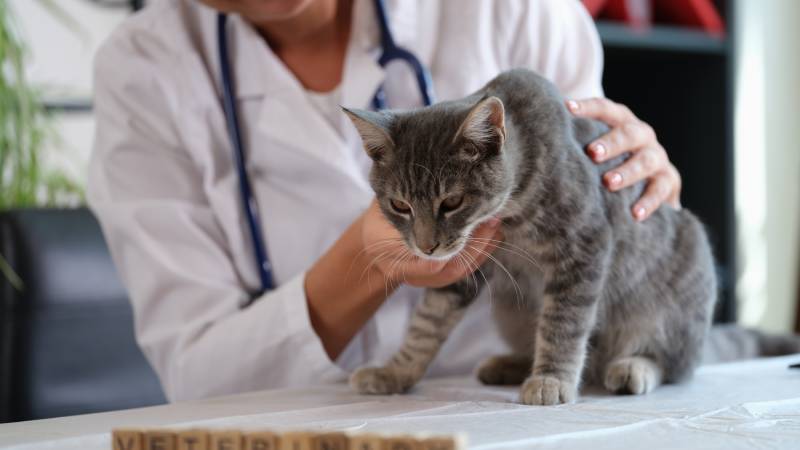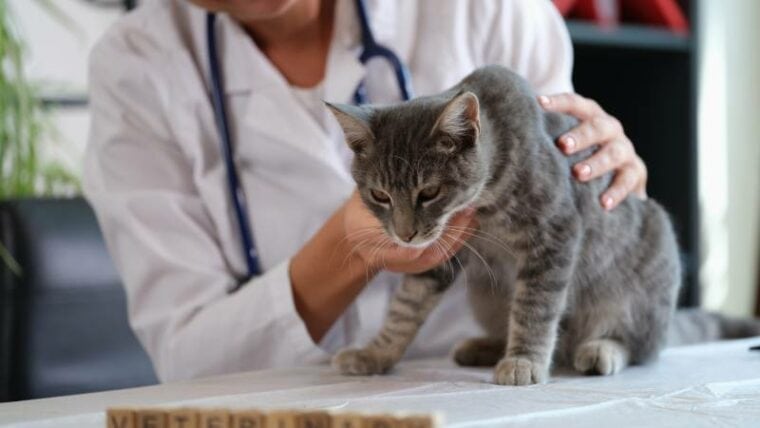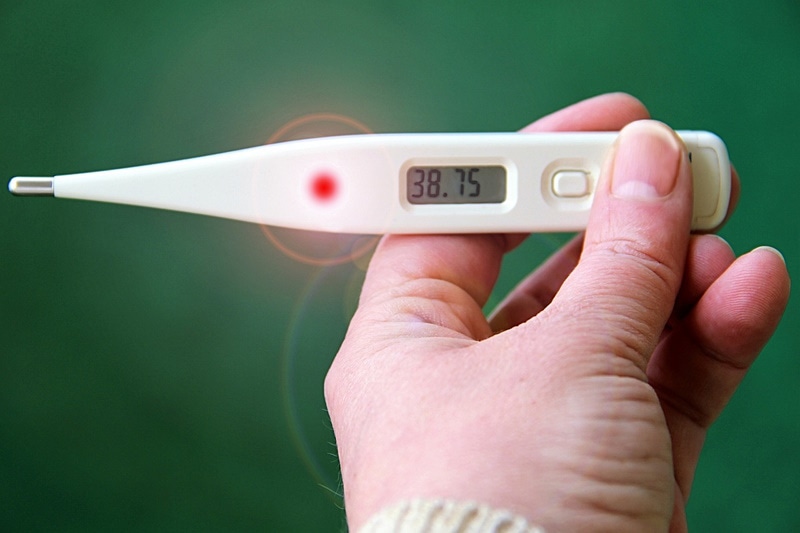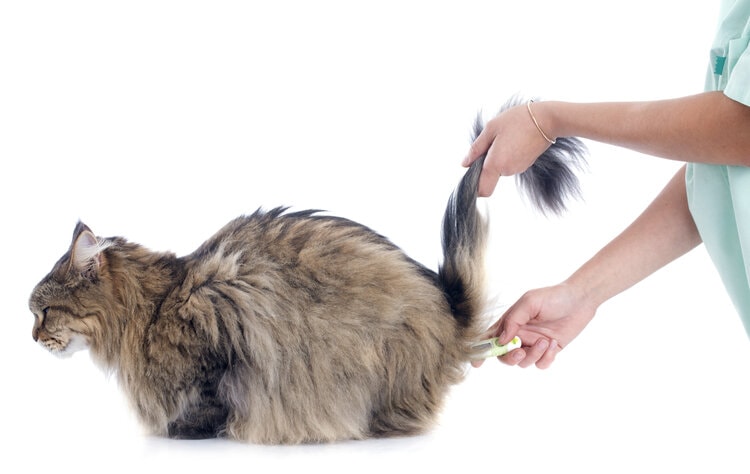- May 2, 2024
How Do I Know if My Cat Has a Fever? 7 Vet-Reviewed Signs to Look For



The information is current and up-to-date in accordance with the latest veterinarian research.
Cats can get fevers just like humans, and they can make your cat feel lousy. Cats are masters of disguise when they are sick, and odds are you won’t know your cat even has a fever unless you check their body temperature. But it is always helpful for you to know the signs that your cat might be sick, how to properly check their body temperature, and, most importantly, what is normal and what is out of the safe range or even a medical emergency.
In this guide, we’ll target the signs your cat may have a fever and what to do if your cat has one. Read on to learn more.

The 7 Signs That Your Cat Might Be Sick & Could Have a Fever
1. Lethargy

Lethargy is a common sign your cat is not feeling well, and it also may be a sign that your cat has a fever. A lethargic cat will show no interest in activities, especially ones your cat usually enjoys, and your cat will want to sleep instead of playing. However, lethargy is not a sure sign your cat has a fever, as it could indicate an entirely different medical issue. For this reason, a trip to the vet is recommended for assessment.
2. Loss of Appetite and Thirst
When you’re sick with a fever, you typically have no appetite, and cats are no different. While this is a common consequence of a fever, it is also not a definitive sign, as other illnesses can cause a loss of appetite and thirst.
A complete loss of interest in drinking water is a dire situation and requires immediate medical attention to keep dehydration from setting in, which can be fatal in cats in severe situations, especially if not treated quickly.
3. Hiding

Hiding is one of the more common signs of illness in cats, and it can indicate that your cat might have a fever. Hiding is especially concerning if your cat does not normally display this type of behavior. However, cats sometimes hide due to stress and not necessarily because they are sick. If you can persuade your cat to come out of hiding, monitor your cat’s behavior. If your cat goes back to acting normal, continue to monitor the behavior to determine if a trip to the vet is warranted.
4. Shivering
If the environmental temperature is not cold, then shivering is a possible indicator that your cat might have a fever. However, cats can also shiver as a result of fear or stress, which might also be the case if the other issues mentioned above are not present. If your cat is shivering, we recommend a trip to the vet for assessment.
5. Higher than Normal Body Temperature

If you’re sure something is off with your cat and are comfortable, you can use a rectal thermometer to check for a fever. A cat’s normal body temperature ranges from 100.4 degrees Fahrenheit to 102.5 degrees Fahrenheit—anything over 104 degrees Fahrenheit is considered a fever, indicating your cat needs to be checked by a vet. If the body temperature has reached 106 degrees Fahrenheit, this is a medical emergency. At that temperature, organs can suffer damage. At the end of this post, we will explain how to measure your cat’s body temperature, along with some tips.
6. Rapid Heartbeat/Rapid Breathing
A rapid heartbeat or rapid breathing can certainly be a sign of an underlying illness, such as anemia, congestive heart failure, infection, low blood pressure, and other ailments. A rapid heart rate or rapid breathing is a clear indicator that something is wrong and can be accompanied by a fever, to which an examination is in order to determine the cause.
7. Loss of Grooming Habits
Cats love to groom themselves, and if they suddenly lose interest, a fever could be present, especially if other signs are present, such as lethargy, loss of appetite, or other factors mentioned above. Your cat is not feeling well if grooming habits come to a screeching halt, which is a clear indicator an examination is in order. Of course, you need to be very observant of your cat’s daily behavior to note this before their coat reaches a serious level of messiness.

Possible Causes of Fevers in Cats
Fever in cats is a sign, not a disease, so it can have many potential causes and are often activated by the following conditions:
- A tumor
- Bacterial infections
- Fungal infections
- Tooth abscess
- Injury from trauma
- Certain medications
- Viral infections (FeLV, herpes virus, etc.)
How to Take Your Cat’s Temperature

Now that we’ve determined possible causes for your cat’s fever, let’s discuss how you take your cat’s temperature to know for sure. Again, if you’re uncomfortable taking your cat’s temp, carry your cat to the vet for an examination.
A pediatric or digital thermometer is the most accurate to use, and you should never use a glass thermometer because it can shatter and hurt your cat.
At any rate, grab the following supplies before you begin:
- Digital thermometer
- Lubricant (can use petroleum jelly)
- Rubbing alcohol
- Paper towels
- Treats!
Step-By-Step Guide for Taking Your Cat’s Temperature Using a Thermometer
- Sometimes, it’s advisable to enlist the help of a friend to avoid getting scratched or bitten by your cat while performing this task. You know your cat the best, and if you feel you can proceed independently, proceed with caution. Also, if your cat is not very tolerant to handling, you might need to use a towel to roll them like a burrito and prevent them from hurting you or your friend.
- Coat the tip with the lubricant, and avoid inserting the thermometer without lubricant—doing so will be uncomfortable for your cat, which can result in retaliation.
- Gently lift the tail to expose the anus. Delicately insert the lubricated tip of the thermometer into the anus, approximately 1 inch. You can gently twist the thermometer from side to side to allow the anal muscles to relax.
- Remove the thermometer when you hear the “beep.”
- Clean the thermometer with rubbing alcohol.
- Give your cat a treat only if they allow this manipulation in a peaceful manner (refrain from giving a treat if they fight a lot or if your cat is vomiting).

Conclusion
No cat owners want their cats to have a fever, but sometimes, our feline fur babies get sick. We hope this article helps you in the event your cat develops signs of being sick and you suspect they have a fever. The most important takeaway is that being observant of your cat’s behavior and knowing their normal body temperature is very valuable. A fever is not a disease by itself but rather just a sign that something is going on. While knowing how to check your cat’s body temperature is great, you will still need to take your cat to the vet for a diagnosis of the exact cause and appropriate treatment.
Remember that anything over 102.5 degrees Fahrenheit is above normal body temperature. At 104 degrees Fahrenheit, your cat has a fever, and anything over 106 degrees Fahrenheit is a medical emergency.
Featured Image Credit: megaflopp, Shutterstock
Tags
What do you think?
Related Articles

New Puppy Checklist: Gear You’ll Need for Your New Dog
Getting a new puppy is really exciting, but before you welcome them home, it’s important to prepare your space for them. Since puppies need a

How Big Do Mini Poodles Get? Vet Reviewed Average Weight & Growth Chart – Dogster
The information is current and up-to-date in accordance with the latest veterinarian research. Learn more » When you buy a Miniature Poodle, you might not

Can Police Dogs Smell Nicotine? Vet Verified Facts & Info – Dogster
The information is current and up-to-date in accordance with the latest veterinarian research. Learn more » While cigarette sales have been declining steadily for decades,

How Old Is 5 in Dog Years? Vet-Approved Guide to Each Size of Dog – Dogster
The information is current and up-to-date in accordance with the latest veterinarian research. Learn more » A common method for calculating a dog’s age is

